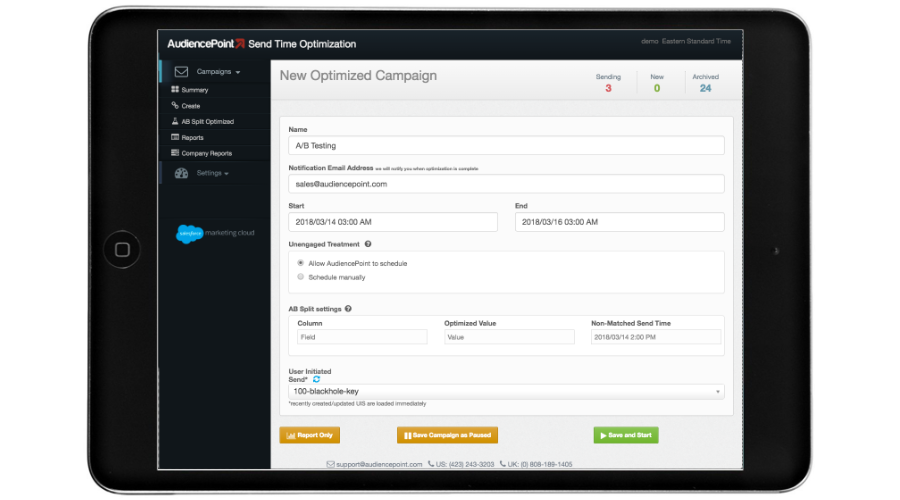AudiencePoint is thrilled to announce our new integration with Klaviyo! AudiencePoint is looking for partners to pilot our...
Email marketing is still relevant and should be part of your marketing strategy. This article will explain why email marketing is effective, provide you with some email marketing effectiveness statistics, and outline metrics you should be tracking to ensure your emails are as effective as possible.
Effectiveness of Email Marketing Statistics
Email marketing effectiveness statistics show that email is still an essential part of any brand’s marketing plan. Here are some email effectiveness statistics that stand out:
- Research has shown that consumers spend 138% more when they are marketed to through email compared to when no emails are sent out.
- The average return on investment (ROI) for marketing emails is $36 for every $1 spent. Studies have also shown that the top 18% of companies achieve an ROI of $70 for every $1 spent.
- When compared to social media advertising on Facebook and Twitter, email marketing is 40 times more effective.
These statistics show just how effective email marketing can be and why you should take advantage of the power of email as part of your marketing strategy.
Which Metrics Should You Track to Measure the Success of Email Marketing?
To help measure the success of email marketing, there are specific metrics you should track. Email marketing success metrics that are important to track include:
- Bounce rate
- Click-through rate
- Conversions
- List growth rate
- Open rate
- Return on investment (ROI)
- Unsubscribes
Tracking and optimizing each of these metrics will help ensure the success of your email campaigns. AudiencePoint’s email insight software can help you track these metrics by providing helpful data for your marketing emails. The following sections will provide information on what each of these email success metrics means and how they impact the effectiveness of your marketing emails.
How Bounce Rate Impacts Email Effectiveness
Email bounce rate is the percentage of emails that are not accepted by the receiving domain out of the number of emails sent. There are several reasons emails can bounce, including:
- Flagged content in the email
- Poor sender reputation due to spam complaints or low open rates
- Restrictive DMARC record on your sending domain
- Server outages
- The email address no longer exists
- The inbox is full
Tracking the bounce rate of your emails is essential to ensure that your email subscribers are actually receiving the content you send out. If emails bounce, your emails can’t be effective, since your subscribers won’t get them in the first place. AudiencePoint’s email insight software can provide you with actionable data on how you can improve your email campaigns and lower your bounce rate. Our software identifies which of your subscribers are engaged vs inactive, so you can send emails only to subscribers who are likely to open them.
How Click-Through Rate Impacts Email Effectiveness
Click-through rate is a big indicator of an email’s effectiveness. The click-through rate is the percentage of recipients who click on a link within an email. Having a high click-through rate is a sign that your email content is engaging, that you have a solid call to action, and that readers are responding positively. Link clicks are essential for increasing web traffic, generating more conversions, and getting subscribers interested in what you have to offer.
How Conversions Are a Sign of Email Effectiveness
The conversion rate is based on the percentage of recipients who take an intended action after opening an email. Common types of conversions are sales, sign-ups, subscriptions, or app installs. High conversion rates show that your emails are effectively helping you achieve your main goal from email marketing. This leads to increased revenue and company success.
How List Growth Rate Is a Sign of Email Effectiveness
List growth rate is the rate at which you gain new subscribers to your email list. If your email list is continuously growing, it is a sign that you are effectively gaining new subscribers through whatever route you are choosing to promote email sign-ups.
List growth rate also takes into account the number of email unsubscribes or opt-outs. If your list is continually growing, it also means that people are subscribing at a higher rate than those who are unsubscribing because they are likely interested in your emails.
How Open Rate Impacts Email Effectiveness
The open rate for emails is the percentage of recipients who open an email you send. High open rates show that your email subscribers are engaged with your content and that your subject lines are effective at getting people to open the email.
Open rate is also essential because a low open rate can lead to emails being rejected by the server or sent to spam. When this happens, it is hard to recover email sender reputation and get servers to start accepting your emails again. So continuously working to keep subscribers engaged is vital for the long-term success of your email marketing efforts.
Note: While open rate is an important metric, the way it is tracked and calculated has been impacted by Apple’s current mail privacy policy (MPP), which opens emails on Apple’s own proxy servers before they land in a recipient’s inbox. This inflates open rates when they are tracked through email marketing software and changes the way the email open rate metrics will be used going forward.
However, AudiencePoint is aware of the effects of MPP, and our email insight software can help identify Apple MPP opens to isolate them from reporting. This helps you manage your email marketing strategy and track email marketing data effectively.
How Return on Investment (ROI) Indicates Email Effectiveness
ROI is the amount of revenue gained compared to the dollar amount invested in creating a marketing email. ROI is an important metric for email effectiveness, because it shows how well your investment in email marketing is paying off in terms of sales.
How Unsubscribes Impact Email Effectiveness
Unsubscribes are the number of people who unsubscribe or opt-out from receiving future marketing emails from your company. If a high number of people are unsubscribing, it is likely a sign that your email content isn’t engaging or isn’t satisfying your subscribers’ needs. A high unsubscribe rate can also indicate that people are being subscribed to your email list when they don’t want to be. Ensuring you provide value in emails and letting new subscribers know exactly what your marketing emails will be like before they subscribe are good ways to reduce the number of unsubscribes.
What Percentage of Sales Should Come from Email Marketing?
Depending on your industry, email marketing revenue can make up a significant percentage of your overall sales. On the top end, a good metric to aim for is that 25-35% of your sales should come from email marketing. Being in this percentage range shows that your emails are effectively generating revenue as part of your overall marketing efforts.
Is Email Marketing Dead?
Email marketing is not dead. In fact, 37% of brands are increasing their email marketing budget, due to its effectiveness. While the top email marketing strategies have changed over the years, it is still possible to get great results and a high return on investment when you put the time and effort into developing an email campaign.
Email Usage Statistics Facts
Email usage statistics also show that email marketing is still a viable option to use as part of your company’s marketing strategy. A large percentage of people use email every day and often check it multiple times a day, so email is far from being obsolete.
What Percent of the World Uses Email?
Over 4 billion people actively use email worldwide. This means over 50% of people worldwide are active email users. With so many people using email, email marketing can effectively reach consumers in many different demographics, locations, and niches.
How Many Emails Does the Average Person Receive Per Day 2022?
It is estimated that the average person receives between 100-120 emails per day in 2022. The volume of emails that people receive makes for more clutter in email marketing. However, making your emails more engaging through writing eye-catching subject lines, providing valuable content, and investing in high-quality email design will make subscribers want to open and read your content.
What Percentage of Businesses Use Email Marketing?
About 80% of businesses use email marketing for customer acquisition and retention. Email marketing effectively keeps customers engaged and keeps certain brand names at the top of their minds when they need to make a purchase.
What Percentage of Emails are Opened?
On average, the email open rate is around 21.33% across all industries (excluding Apple MPP opens.) Creating engaging subject lines is one of the top ways to increase your email open rate. Consistently providing valuable content will also make email subscribers want to open your emails and even look forward to reading them. Improving these aspects makes it possible to get your open rates above the average of 21.33%.
Conclusion
Email marketing is still an extremely relevant way to market your company’s products and services. People worldwide use email every day, so branded emails are an effective way to reach people and get their attention. Tracking important email metrics is essential to set your email marketing campaign up for success.
If you would like additional help with email marketing, AudiencePoint’s email insight software can help. AudiencePoint makes the email marketing process easy by providing you with actionable insights into how you can improve your campaign. For example, our software helps you identify which subscribers are active vs. inactive, so you are only sending out emails to readers likely to open and interact with them. Our software can also exclude Apple MPP opens, so that you can be sure you are working with accurate metrics. These examples are just a couple of the ways that our email insight software can help. Contact us today to learn more about how we can help you nail your email marketing campaigns.




